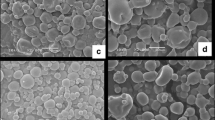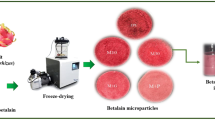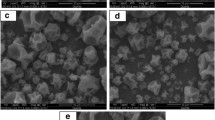Abstract
The juçara fruits (Euterpe edulis Martius), native to the Atlantic Forest, are rich in anthocyanins. To preserve the anthocyanins in juçara fruit pulp, this study aimed to evaluate the effectiveness of microencapsulation by spray drying and freeze drying with maltodextrin (dextrose equivalent 16.5 to 19.5) and gum arabic in different proportions. The obtained microparticles were characterized by quantifying the total polyphenol and anthocyanin contents, by performing differential scanning calorimetry, thermogravimetry, and infrared spectroscopy and by using scanning electron microscopy to analyze the morphology of the particles. The total amount of polyphenols in the fruit pulp was 750 ± 16.7 mg GAE/100 g of the freeze-dried sample. The total anthocyanins in the fruit pulp was 181.25 ± 5.36 (mg/100 g). The microparticles were formed by employing maltodextrin and gum arabic in a 1:1 proportion as the polymeric matrix; the mixtures of pulp and polymeric matrix were prepared in proportions of 2:3 and 2:1, preserving up to 83.69% of the anthocyanin content. Lyophilization of the 2:1 mixture resulted in an anthocyanin content of 116.89 ± 4.43 (mg/100 g), whereas lyophilization of the 2:3 mixture resulted in 151.68 ± 1.39 (mg/100 g) anthocyanin content, which did not differ from the value obtained by spray drying the 2:3 mixture (150.76 ± 5.79 (mg/100 g)). Thermal analyses showed that the microparticles obtained by freeze drying at a ratio of 2:3 presented greater resistance to degradation with increasing temperature. The incorporation of the pulp in the polymeric matrix was demonstrated by IR analyses. Microparticles obtained by freeze drying showed the formation of various-sized flakes, whereas those obtained by spray drying were spherical in shape. Microencapsulation is a possible alternative for improving the stability of the anthocyanins in this fruit.


Similar content being viewed by others
Abbreviations
- C3G:
-
cyanidin-3-O-glucoside
- DE:
-
dextrose equivalent
- DSC:
-
differential scanning calorimetry
- ESI:
-
electrospray ionization
- Liof.:
-
lyophilization
- MRM:
-
multiple reactions monitoring
- PM:
-
polymeric matrix
- RT:
-
retention time
- SD:
-
spray dried
- SEM:
-
scanning electron microscopy
- TGA:
-
thermogravimetric analysis
References
Schulz M, da Silva Campelo Borges G, Gonzaga LV, Oliveira Costa AC, Fett R (2016) Jucara fruit (Euterpe edulis Mart.): sustainable exploitation of a source of bioactive compounds. Food Res Int 89(Pt 1):14–26. https://doi.org/10.1016/j.foodres.2016.07.027
Leitman P, Henderson A, Noblick L, Martins R, Soares K (2014) ARECACEAE in Lista de Espécies da Flora do Brasil. Jardim Botânico do Rio de Janeiro. Publicado em Flora do Brasil. http://floradobrasil.jbrj.gov.br/jabot/floradobrasil/FB15711 Acessed in March 28, 2018
Bicudo MOP, Ribani RH, Beta T (2014) Anthocyanins, phenolic acids and antioxidant properties of jucara fruits (Euterpe edulis M.) along the on-tree ripening process. Plant Foods Hum Nutr 69(2):142–147. https://doi.org/10.1007/s11130-014-0406-0
Borges GDSC, Vieira FGK, Copetti C, Gonzaga LV, Zambiazi RC, Mancini Filho J, Fett R (2011) Chemical characterization, bioactive compounds, and antioxidant capacity of jussara (Euterpe edulis) fruit from the Atlantic forest in southern Brazil. Food Res Int 44(7):2128–2133. https://doi.org/10.1016/j.foodres.2010.12.006
de Castro CA, Natali AJ, Cardoso LM, Ferreira-Machado AB, Novello AA, da Silva KA, Tafuri NF, da Matta SL, Pedrosa ML, Peluzio Mdo C (2014) Aerobic exercise and not a diet supplemented with jussara acai (Euterpe edulis Martius) alters hepatic oxidative and inflammatory biomarkers in ApoE-deficient mice. Br J Nutr 112(3):285–294. https://doi.org/10.1017/s000711451400083x
Nazzaro F, Orlando P, Fratianni F, Coppola R (2012) Microencapsulation in food science and biotechnology. Curr Opin Biotechnol 23(2):182–186. https://doi.org/10.1016/j.copbio.2011.10.001
Singleton VL, Orthofer R, Lamuela-Raventós RM (1999) [14] analysis of total phenols and other oxidation substrates and antioxidants by means of folin-ciocalteu reagent. Methods Enzymol 299:152–178. https://doi.org/10.1016/S0076-6879(99)99017-1
Rocha GA, Fávaro-Trindade CS, Grosso CRF (2012) Microencapsulation of lycopene by spray drying: characterization, stability and application of microcapsules. Food Bioprod Process 90:37–42. https://doi.org/10.1016/J.FBP.2011.01.001
Tonon RV, Brabet C, Hubinger MD (2009) Influence of drying air temperature and carrier agent concentration on the physicochemical properties of açai juice powder. Food Sci Technol 29(2):444–450. https://doi.org/10.1590/S0101-20612009000200034
Giusti MM, Wrolstad RE (2001) Characterization and measurement of anthocyanins by UV-visible spectroscopy. In: Wrolstad RE (ed) Current protocols in food analytical chemistry. Wiley, New York, pp F1.2.1–F1.2.1
Osorio C, Acevedo B, Hillebrand S, Carriazo J, Winterhalter P, Morales AL (2010) Microencapsulation by spray-drying of anthocyanin pigments from corozo (Bactris guineensis) fruit. J Agric Food Chem 58(11):6977–6985. https://doi.org/10.1021/jf100536g
Mahdavee Khazaei K, Jafari SM, Ghorbani M, Hemmati Kakhki A (2014) Application of maltodextrin and gum arabic in microencapsulation of saffron petal’s anthocyanins and evaluating their storage stability and color. Carbohydr Polym 105:57–62. https://doi.org/10.1016/J.CARBPOL.2014.01.042
Burin VM, Rossa PN, Ferreira-Lima NE, Hillmann MC, Boirdignon-Luiz MT (2011) Anthocyanins: optimisation of extraction from cabernet sauvignon grapes, microcapsulation and stability in soft drink. Int J Food Sci Technol 46(1):186–193. https://doi.org/10.1111/j.1365-2621.2010.02486.x
Wang W-D, Xu S-Y (2007) Degradation kinetics of anthocyanins in blackberry juice and concentrate. J Food Eng 82(3):271–275. https://doi.org/10.1016/j.jfoodeng.2007.01.018
Ezhilarasi P, Indrani D, Jena B, Anandharamakrishnan C (2013) Freeze drying technique for microencapsulation of garcinia fruit extract and its effect on bread quality. J Food Eng 117(4):513–520. https://doi.org/10.1016/j.jfoodeng.2013.01.009
Sarkar S, Gupta S, Variyar PS, Sharma A, Singhal RS (2013) Hydrophobic derivatives of guar gum hydrolyzate and gum arabic as matrices for microencapsulation of mint oil. Carbohydr Polym 95(1):177–182. https://doi.org/10.1016/j.carbpol.2013.02.070
Mothé C, Rao M (2000) Thermal behavior of gum arabic in comparison with cashew gum. Thermochim Acta 357:9–13. https://doi.org/10.1016/S0040-6031(00)00358-0
Peron DV, Fraga S, Antelo F (2017) Thermal degradation kinetics of anthocyanins extracted from jucara (Euterpe edulis Martius) and "Italia" grapes (Vitis vinifera L.), and the effect of heating on the antioxidant capacity. Food Chem 232:836–840. https://doi.org/10.1016/j.foodchem.2017.04.088
Cano-Higuita DM, Vélez HAV, Telis VRN (2015) Microencapsulation of turmeric oleoresin in binary and ternary blends of gum arabic, maltodextrin and modified starch. Ciênc Agrotec 39(2):173–182. https://doi.org/10.1590/S1413-70542015000200009
Costa A, Nunes J, Lima B, Pedrosa C, Calado V, Torres A, Pierucci A (2015) Effective stabilization of CLA by microencapsulation in pea protein. Food Chem 168:157–166. https://doi.org/10.1016/j.foodchem.2014.07.016
Acknowledgements
We thank de Fundação de Amparo à Pesquisa e Inovação do Espírito Santo (FAPES) for a fellowship (RAM and PMMC), and we appreciate the financial support from (TO # 665/2016, N° 80633161) and SEAG. Thanks also to the Laboratório de Saneamento (UFES) and to Tommasi Analítica LTDA for the collaboration on the chromatographic analyses and to CNPq (445987/2014-6, 401409/2014-7, 310680/2016-6-PQ) and Universidade Vila Velha for the financial support.
Author information
Authors and Affiliations
Corresponding author
Ethics declarations
Conflict of Interest
The authors declare that they have no conflict of interest.
Human and Animal Studies
This article does not contain any studies with human or animal subjects.
Electronic Supplementary Material
ESM 1
(DOCX 151 kb)
Rights and permissions
About this article
Cite this article
Mazuco, R.A., Cardoso, P.M.M., Bindaco, É.S. et al. Maltodextrin and Gum Arabic-Based Microencapsulation Methods for Anthocyanin Preservation in Juçara Palm (Euterpe edulis Martius) Fruit Pulp. Plant Foods Hum Nutr 73, 209–215 (2018). https://doi.org/10.1007/s11130-018-0676-z
Published:
Issue Date:
DOI: https://doi.org/10.1007/s11130-018-0676-z




